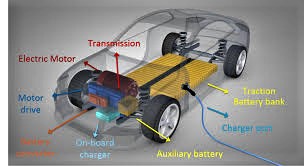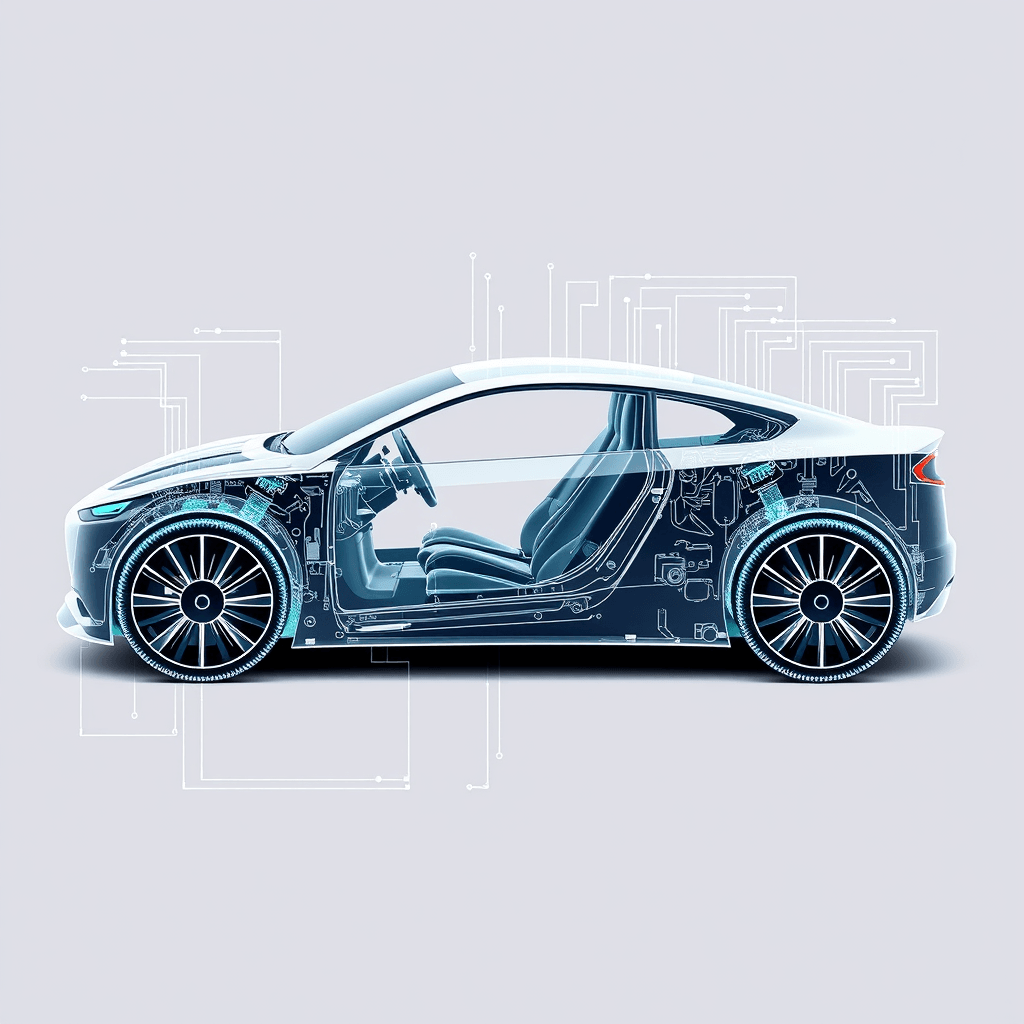This article provides details about the main components of an electric car and its functions. Information is about the battery-electric car that is powered by the traction battery pack. We will look at the main parts which are: the battery, the electric motor, and the power electric converter.
In the figure are the key parts of an electric car. First, we have a charging port with the connector and cable. Then it is a high voltage traction battery and the low voltage auxiliary battery. Are an electric motor and a transmission system that propel the car. Plus, several power electronic converters used for battery charging, for
driving the motors and for regenerative braking.

The schematic second figure shows how the different components are connected in an electric car.

Electric Cars Components
Charging Port
The first component we look is the charging port with the connector and cable. Together these connect to an external power supply to charge the traction battery pack.
On-Board-Charger
If the car gets current from the conventional electric grid you need an on-board charger, that is a power electronic converter. A power converter is a semiconductor device acting like speed switches. This device modifies the input voltage and current. The ob-board charger converts the incoming alternating current or AC power supplied via the charge port to direct current or DC power for charging the traction battery.
High- Voltage Traction Battery
A pack of batteries is the basic piece of the electric car. Generally, the traction battery pack is located at the bottom of the car. The main role is to store energy for the propulsion of the car. The battery monitors and regulates the battery charging characteristics such as voltage, current, and charge rate.
Measure unit for the range of battery or the content of battery is kilowatt-hours. The range of batteries for electric cars is 10-100kwh.
For electric cars are applying different types of battery technologies.
First is the lead-acid. The solution to use lead-acid batteries for an electric vehicle is limited. These batteries have low acid density, sensitivity to temperature and, a short life cycle.
Next is the Nickel- Metal-Hydride (NiMH) batteries. The batteries work for traction and for high energy content. Lithium-based batteries are the most popular. Lithium batteries Lithium-ion-liquid electrolyte and, Lithium-ion-polymer electrolyte batteries. Lithium-ion batteries have high energy density.
Battery Power Converter
The power flows from the battery to the motor and to the vehicle accessories like light and audio system is generating. To generate the power flow between these devices it is necessary to use a power electric converter.
In an electric car, a DC to DC converter – the battery power converter- increase the battery power voltage of the traction battery pack to a higher voltage needed to drive motor drive.
A secondary DC to DC converter is used to down the voltage of the traction battery pack to charge the lower voltage auxiliary battery.
Motor Drive
The component contains the speed, torque, and rotational direction of the motor.
Depending on the motor, the motor drive can be DC to AC inventor or a DC/DC converter that controls the power flow between the battery and the motor. The motor drive is capable to move the power to the motor for propulsion but to remove out the motor for regenerative braking.
Electric Motor
The electric motor is one of the vital components of an electric car. The electric motor converts electrical energy to mechanical energy for driving the wheels by the transmission. Electric cars use a single gear transmission with differential compared to variable gear from internal combustion engine vehicles.
The electric cars are automatic gear cars because the electric motor delivers close full torque at all speeds. Further, the same electric motor works either for propulsion or for regenerative braking. Commonly used motor types: Brushed DC motor, Induction motor, Permanent magnet motor, Switched reluctance motor.
Auxiliary battery and Power electronics converter
The auxiliary battery provides electricity to start the car. This fact happens before the traction battery to be coupled. The Auxiliary battery aliments vehicle accessories. The power electronic converter controls different power converters directly. It uses the driver accelerator and brake pedals to control the power flow and select the operating mode between driving and regenerative braking. It controls the on-board charger and the battery charging together with the battery management system